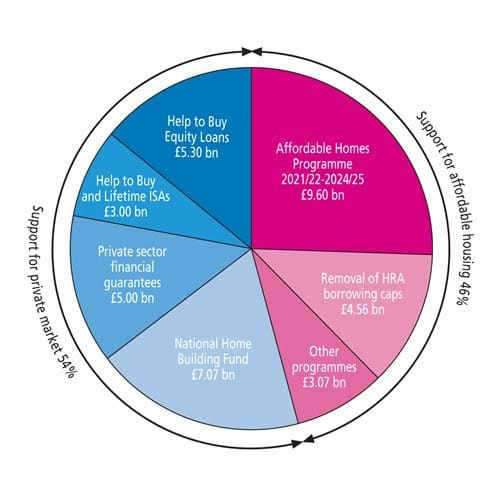29 Oct 2021
Affordable housing investment to lead the way out of the crisis?
The UK Housing Review’s annual assessment of government support for housing investment and what proportion goes towards affordable housing showed a significant shift this year. In Wales, Scotland, and Northern Ireland most support (between 74 and 100 per cent) goes towards affordable housing, whereas in England most has gone to private housing. In 2020, three-quarters was aimed at supporting the private market. Before the Autumn Budget, the picture for England (see chart below) was more favourable: a rather bigger Affordable Homes Programme, coupled with the ending of some of the Cameron-Osborne incentives to the private market, shifted affordable housing’s share to 46 per cent.

Government support for housing investment in England, pre-Budget
Source: Based on UK Housing Review 2021, table 2.4.1.
This changed on 27 October 2021 when the Chancellor announced no new money for affordable housing, but an additional £1.8 billion to help private developers tackle brownfield sites. Our next assessment, early next year, will factor in whatever part of this money turns out to be a new spending commitment.
The big question is still whether sufficient money is being directed to affordable housing in England. Before the pandemic, there was already evidence that needs had increased above the levels which CIH and others believe are needed: which should include 90,000 new social rented units per year. But since then, problems have worsened: overcrowding has increased, some nine per cent of private renters are in arrears, and more than one-fifth of private renters have lost income (at least £100 per month) during the pandemic.
Grant-funded affordable housing completions in England totalled 33,044 in 2020/21, rather below the annual average of 38,800 since 2010/11, in part because of the pandemic. The Johnson government has set a target of 180,000 grant-funded starts for 2021-26 (i.e. 36,000 annually): essentially this is what is being achieved now and looks to fall well short of rising needs.
The picture is even worse if the focus is on social rented housing, with just 2,102 completed with grant aid in 2020/21, although non-grant-funded completions might well raise this to around 5,000. However, an indication of difficulties of expanding such output comes from London, where the Mayor aimed to build 11,000 new council houses to be let close to social rents over the period 2018-20, and just 1,632 have been built so far.
In Wales, delays in producing statistics again make it difficult to report on progress in affordable housing delivery, although perhaps surprisingly the Welsh Government managed to slightly overspend their allotted budget: £223 million was allocated for 2020/21 and £228 million actually spent.
In Northern Ireland, the target under the Social Housing Development Programme is based on starts, aiming to achieve 1,850 annually. Delivery over the last two financial years has shown some remarkable peaks and troughs, with starts falling to only 761 in 2019/20 but shooting up to 2,403 in 2020/21. Unusually, 70 per cent of this record level was achieved in the last quarter of the year, presumably reflecting a large backlog of work which eventually began as the pandemic eased.
In Scotland, achievement of the 50,000 affordable homes target over the five years to March 2021 was thwarted by the pandemic, with completions falling to 6,466 in the final year whereas they had exceeded 9,000 in the two previous years. Providers must now deliver the delayed completions this year, while also beginning the next round of the programme covering the five years to 2026. While the new five-year target is close to meeting assessed need, there are questions over whether the sector can provide better quality homes within the planned budget or whether rents will have to increase to meet higher standards.
In fact, the problem of competition for resources between new build programmes and the needs of the existing stock is a UK-wide problem, given pressures on landlords to meet fire safety requirements and decarbonise their stock to achieve government ‘net zero’ targets, taken together with the increased cost of building materials. This is an issue which we plan to return to in the 2022 edition of the UK Housing Review.
You can now download the 2021 UK Housing Review Autumn Briefing Paper.
John Perry is a policy advisor at the Chartered Institute of Housing. He edits the UK Housing Review and also advises on a wide range of subjects including planning, local authority finance, plus much more. John is a chartered CIH member.


